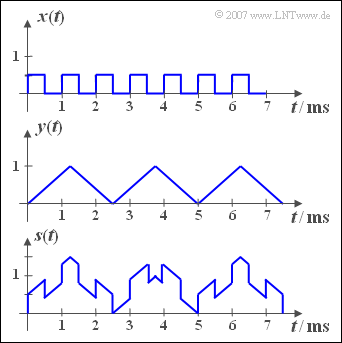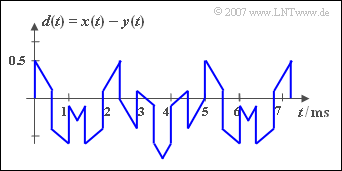Difference between revisions of "Aufgaben:Exercise 2.1Z: Sum Signal"
| Line 20: | Line 20: | ||
| − | '' | + | ''Hints:'' |
| − | * | + | *The exercise belongs to the chapter [[Signal_Representation/General_Description|General description of periodic signals]. |
| − | * | + | *With the interactive applet [[Applets:Periodendauer_periodischer_Signale|Periodendauer periodischer Signale]] the resulting period duration of two harmonic oscillations can be determined. |
| − | === | + | ===Questions=== |
<quiz display=simple> | <quiz display=simple> | ||
| − | { | + | {What is the period duration $T_x$ and the base frequency $f_x$ of the signal ${x(t)}$? |
|type="{}"} | |type="{}"} | ||
$f_x\ = \ $ { 1 3% } $\text{kHz}$ | $f_x\ = \ $ { 1 3% } $\text{kHz}$ | ||
| − | { | + | {What is the period duration $T_y$ and the base frequency $f_y$ of the signal ${y(t)}$? |
|type="{}"} | |type="{}"} | ||
$f_y\ = \ $ { 0.4 3% } $\text{kHz}$ | $f_y\ = \ $ { 0.4 3% } $\text{kHz}$ | ||
| − | { | + | {Determine the base frequency $f_s$ as well as the period duration $T_s$ of the sum signal ${s(t)}$ and verify your results with the help of the sketched signal. |
|type="{}"} | |type="{}"} | ||
$T_s\ = \ $ { 5 3% } $\text{ms}$ | $T_s\ = \ $ { 5 3% } $\text{ms}$ | ||
| − | { | + | {What is the period duration $T_d$ of the difference signal ${d(t)}$ ? |
|type="{}"} | |type="{}"} | ||
$T_d\ = \ $ { 5 3% } $\text{ms}$ | $T_d\ = \ $ { 5 3% } $\text{ms}$ | ||
| − | { | + | {What is the period duration $T_w$ of the signal ${w(t)} = {u(t)} + v(t)$? |
|type="{}"} | |type="{}"} | ||
$T_w\ = \ $ { 500 3% } $\text{ms}$ | $T_w\ = \ $ { 500 3% } $\text{ms}$ | ||
| Line 55: | Line 55: | ||
</quiz> | </quiz> | ||
| − | === | + | ===Solution=== |
{{ML-Kopf}} | {{ML-Kopf}} | ||
'''(1)''' Für das Rechtecksignal gilt $T_x = 1 \,\text{ms}$ ⇒ $f_x \hspace{0.15cm}\underline{= 1 \, \text{kHz}}$. | '''(1)''' Für das Rechtecksignal gilt $T_x = 1 \,\text{ms}$ ⇒ $f_x \hspace{0.15cm}\underline{= 1 \, \text{kHz}}$. | ||
Revision as of 00:44, 27 December 2020
The adjacent diagram shows the two periodic signals ${x(t)}$ and ${y(t)}$ , from which the sum signal ${s(t)}$ – sketched in the lower picture – and the difference signal ${d(t)}$ are formed.
Furthermore, in this task we consider the signa ${w(t)}$, which results from the sum of the two periodic signals ${u(t)}$ und $v(t)$ . The base frequencies of the signals are
- $f_u = 998 \,\text{Hz},$
- $f_v = 1002 \,\text{Hz}.$
That is all we know about the signals ${u(t)}$ and $v(t)$ .
Hints:
- The exercise belongs to the chapter [[Signal_Representation/General_Description|General description of periodic signals].
- With the interactive applet Periodendauer periodischer Signale the resulting period duration of two harmonic oscillations can be determined.
Questions
Solution
(2) Für das Dreiecksignal gilt $T_y = 2.5 \,\text{ms}$ und $f_y \hspace{0.15cm}\underline{= 0.4\, \text{kHz}}$.
(3) Die Grundfrequenz $f_s$ des Summensignals $s(t)$ ist der größte gemeinsame Teiler von $f_x = 1 \,\text{kHz}$ und $f_y = 0.4 \,\text{kHz}$.
- Daraus folgt $f_s = 200 \,\text{Hz}$ und die Periodendauer $T_s\hspace{0.15cm}\underline{ = 5 \,\text{ms}}$, wie auch aus der grafischen Darstellung des Signals ${s(t)}$ auf der Angabenseite hervorgeht.
(4) Die Periodendauer $T_d$ ändert sich gegenüber der Periodendauer $T_s$ nicht, wenn das Signal ${y(t)}$ nicht addiert, sondern subtrahiert wird: $T_d = T_s \hspace{0.15cm}\underline{= 5\, \text{ms}}$.
(5) Der größte gemeinsame Teiler von $f_u = 998 \,\text{Hz}$ und $f_{v} = 1002 \,\text{Hz}$ ist $f_w = 2 \,\text{Hz}$.
- Der Kehrwert hiervon ergibt die Periodendauer $T_w \hspace{0.15cm}\underline{= 500 \,\text{ms}}$.

